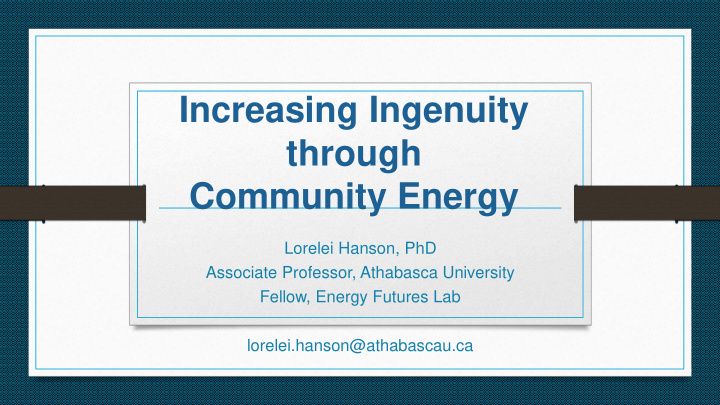



Increasing Ingenuity through Community Energy Lorelei Hanson, PhD Associate Professor, Athabasca University Fellow, Energy Futures Lab lorelei.hanson@athabascau.ca
Our Current Predicament The average concentration of carbon dioxide in the atmosphere is likely to rise by 2.8 parts per million to 411 ppm in 2019 – passing 410 ppm “…either we limit the warming to 1.5 °C over pre-industrial levels, or just a few years after first we don't. Either we reach a tipping point where we start a chain passing the 400 ppm reaction with events way beyond human control, or we don’t…There are no gray areas when it comes to survival. mark. And when I say that I want you to panic I mean that we need to treat the crisis as a crisis... If your house is on fire you run outside and make sure that everyone is out while you call the fire 2 department. That requires some level of panic .” Greta Thunberg SESA Presentation Feb., 7, 2019
Impacts of Climate Change • The Arctic has seen warming 2 to 3 times higher than the global average. • Australia’s heat waves 2018 -19 have killed a third of the country’s flying fox bats • Hundreds of thousands of bream, cod and perch have been killed in New South Wales along a 40 km stretch of the Darling River due to a green algae bloom caused by a combination of high temperatures, chronic low water levels and high nutrient concentrations in the water • Monarch butterfly populations plummeted 86% in California compared to a year ago, which spells disaster for species as numbers already declined 97% since the 1980s. • Phytoplankton levels are down 50% • Researchers in Puerto Rico recorded a 98% decline in insect mass over the past 35 years • Globally species are being lost 1000 times faster than the natural rate of extinction 3 SESA Presentation Feb., 7, 2019
Signs of Hope 4 SESA Presentation Feb., 7, 2019
Energy Transition? …No. “Since 1800 biomass consumption has increased by about 275%, and coal use by more than 60% just since 2000. Rapidly falling costs and growing investments have helped boost wind and solar power, but these energy sources… are building on top of old ones, rather than replacing them … The bottom line: To avoid the worst impacts of climate change, renewables and new technologies will need to do more than build atop CO 2 – intensive fossil fuels — they will need to push out incumbents while at the same time expanding global energy access and reducing the system’s environmental footprint.” - Richard Newell & Daniel Raimi 5 SESA Presentation Feb., 7, 2019
Take away from IPCC 2018 Special Report: cut carbon pollution as much as possible, as fast as possible. Bleached coral in Guam in 2017. Once we reach 2 o C warming above pre-industrial temperatures, the IPCC concludes coral reefs will all die off. - David Burdick/AP SESA Presentation Feb., 7, 2019 6
Thomas Homer Dixon The Ingenuity Gap Ingenuity: sets of instructions that tell us how to arrange the constituent parts of our social and physical worlds in ways that help us achieve our goals. “When things happen faster, in greater numbers, and with greater interactive complexity, we need more ingenuity to make the right decisions at the right time.” p. 25 7 SESA Presentation Feb., 7, 2019
Two forms of Ingenuity: Technical and Social Social ingenuity is a critical prerequisite to technical ingenuity; We need good ideas and technologies, as well as an effective way to integrate them into society. 8 SESA Presentation Feb., 7, 2019
Generation Energy Dialogues Included 60 engagement sessions, over 100 reports, close to 2000 on-line ideas and comments, more than 335,000 responses to polls and quizzes. https://www.nrcan.gc.ca/20093 Principal question asked: “What are the values and principles that Canadians cherish most that should guide our energy future?” • Leadership • Collaboration • Transparency • Conservation & sustainability • Leverage Canada’s diversity • Respect for indigenous rights • Inclusiveness & fairness • Safety & security 9 SESA Presentation Feb., 7, 2019
Democratization of Electricity Citizens want more say in the production, movement and use of energy 10 SESA Presentation Feb., 7, 2019
Community Energy Community energy refers to renewable energy generation that is owned by, and/or governed by people who can benefit through employment, local use, and local economic returns The Lutsel K’e , NWT, Solar Farm (Photo: Robert Cooke) 11 SESA Presentation Feb., 7, 2019
Benefits of Community Energy • Reduces environmental impacts • Creates a stable revenue source for the community • Builds local leadership, energy literacy, governance, entrepreneurship and expertise • Spurs economic development, economic diversification and community resilience “Community energy projects can lead to up to 2.8 times more employment and 46% more economic activity than projects developed by entities outside the community.” – Todd, 2018 12 SESA Presentation Feb., 7, 2019
https://www.pembina.org/pub/ new-energy-map Alberta is ideally suited for community-owned renewable energy • Solar • Wind • Geothermal • Bioenergy (biogas and biomass) https://www.Pembina.org/pub/ alberta-community-solar-guide SESA Presentation Feb., 7, 2019 13
History & Culture Supportive of CE • 1 st CA municipally owned power utility • Birthplace of wind energy in CA • Formation of REAs • 4 th &5 th largest CA co-ops • 31 Credit Unions 14 SESA Presentation Feb., 7, 2019
Support for Community Energy Humankind is facing an increasing risk of a coinciding failures…At the moment these stresses are acting in the background, silently eroding the resilience of these systems. The danger is they will reach a crisis point simultaneously…If we want to close the ingenuity gaps we face in our fast- changing world, we need to reform our human systems. 15 SESA Presentation Feb., 7, 2019
Recommend
More recommend